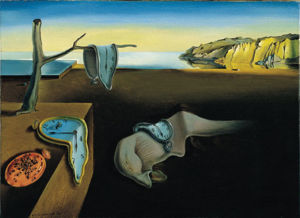Surrealism
Surrealism was an artistic movement that began in the early-1920. It was consisting of dreamlike paintings. Surrealism was based on Freudian philosophies of dream analysis. Surrealism is a word Guillaume Apollinaire is credited for coining.
Surrealist artists aimed to expose psychological truth and as a result created abstract images in order to evoke empathy from the viewer. Highly individualized, the movement relied heavily on the element of the unexpected, borrowed from various Dadaist techniques and eventually came to represent the alienation many experienced in the wake of a war stricken world. [1]
Famous Surrealists

Possibly the most famous surrealist artist was Salvador Dali, who is credited with the surrealist painting The Persistence Of Memory. Other famous surrealists were Max Ernst, Remedios Varo (1908–1963) and René Magritte.
In Mexico, Remedios Varo with Leonora Carrington developed an illusionistic Surrealism.
See also
Rene Magritte, Beautiful World.
